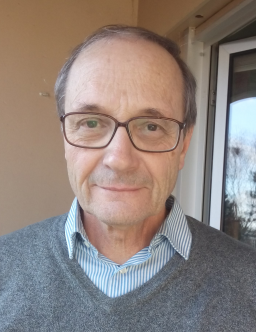|
|
Bernard FABBRODépartement de Physique des Particules
|
Research Interests (French version)
I am a physicist at the Institute of Research on the Fundamental laws of the Universe (IRFU). After working as an experimentalist in nuclear physics and particle physics, I am currently interested in the question of the link between the Huygens-Fresnel principle and quantum mechanics and in the diffraction at large angles.
The diffraction of the wave associated with a particle passing through the aperture of a diaphragm is calculated most often in the framework of the theories of Fresnel-Kirchhoff (FK) and Rayleigh-Sommerfeld (RS1 and RS2), based on the Huygens-Fresnel principle. In these theories, the amplitude of the diffracted wave is a function of the spatial coordinates. So, in the context of quantum mechanics, this amplitude is proportional to the position wave function associated with the quantum state of the particle. In other words, in the FK and RS1-2 theories, the calculation of the amplitude of the diffracted wave is equivalent to the calculation of the wave function of a particle without prior calculation of the quantum state of this particle. This classical wave calculation is used in particular to predict the intensity of the outgoing wave in the Young's two-slits experiment. However, this experiment is considered as an ideal example to introduce the notions of wave-particle duality and quantum interference and, consequently, the basic concepts of quantum mechanics among which those of quantum measurement and of wave function reduction. It is therefore strange that these quantum mechanical concepts are not used in practice to calculate diffraction.
I am currently working on the development of a quantum model of diffraction based on the use of the postulate of wave function reduction) (see: https://arxiv.org/abs/1710.09758 ). The diaphragm with its aperture is a device for measuring the position of the particle. The incident wave is the position wave function of the initial state of the particle. At the time of the position measurement this initial state is projected on a state whose position wave function is first localized at the aperture (postulate of wave function reduction) and then evolves to a state whose position wave function corresponds to the amplitude of the diffracted wave. The model provides the expression of the final quantum state associated with the diffracted wave and predicts the Fraunhofer diffraction over the whole diffraction angle range (0° - 90°). For large diffraction angles, the quantum model and the three theories FK and RS1-2 disagree. It turns out that the discrepancies are significant beyond 60°. However, no experiment seems to have been made so far to accurately measure diffraction at large angles. Such an experiment is underway at the IRAMIS (Radiation-Matter Institute of Saclay).
Curriculum Vitae
Curriculum Vitae.docx
Publications
INSPIRE HEP
http://arxiv.org/abs/1710.09758


